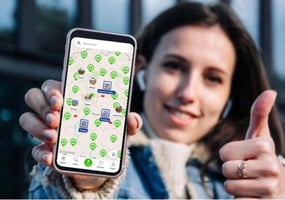Paper versus pixels: What makes the best travel guide?
These days, tour guides and attractions have multiple options for how they choose to represent their content to travelers. We've seen the classic guidebooks from LonelyPlanet and Time Out. On the other hand, getting around a city with a lively local guide is typically an unforgettable experience.

Ready to create the ultimate audio guide? Partner with SmartGuide today!
But the times are changing. Traveling after the introduction of COVID-19 means keeping social distance whenever possible; walking around busy tourist hotspots with a group from various places doesn't sound like the safest option. Apps like SmartGuide have emerged to offer a tour guide system for travel providers and tourists alike, but how does the digital experience rank among other guiding options? Let's take a look.
Book or Paper Guide
Books are the less tourist-friendly option, but serious travelers will collect texts on their favorite destinations. Creating and publishing pamphlets can be costly for attractions. Instead of constantly refreshing the content for visitors, it may be best to choose a more eco-friendly option.
Strengths
Consistency • Low-maintenance distribution • Memento for tourists • Allows for social distance
Weaknesses
Expensive to update and publish • Risk outdated information • Restrictive content space • Extra weight for tourists on-the-go
Live Guides
While it seems nothing beats traveling to a new destination with a local, who's passionately sharing facts and stories, a world with COVID-19 challenges this traditional experience for tourists. Independent traveling is the best option for social distancing. The benefits of this change include saving money on a costly tour guide group to avoid crowds and no allotted time for discovering a new place.
Strengths
Deliver authentic content • Typically positive experience • Not COVID-19 friendly with no social distance
Weaknesses
Expensive • Consistency varies with guides • Limited time for users
Hardware Guides
These typically bulky or outdated devices are another thing to avoid in a world with COVID-19. While this platform allows an attraction's visitors to maintain social distance, it brings about more work for employees with disinfection in mind. There are also limitations regarding what tour guide content can be played aloud for tourists - not to mention a lack of visuals.
Strengths
Cost-effective to maintain • User independence
Weaknesses
Can be expensive to implement • Learning curve for some users • Restrictive content space • Sharing devices is not recommended regarding COVID-19 regulations
App Guides
A mobile application with a well-designed user interface can provide a tour guide system that is easier and more convenient to use than most paper or hardware guides found at attractions. By using a personal device, COVID-19 hygienic standards are met and tourists can travel at their own pace. Apps like SmartGuide provide countless features other guiding options cannot such as personalized content and turn-by-turn navigation!
Strengths
Cost-effective to maintain • Large platform space for consistent content • User independence, social distance
Weaknesses
Can be expensive or difficult to implement • Learning curve for some users
More articles about post-covid recovery through digital guiding technology:
- How to replace hardware audio guide systems with a mobile tour app?
- How to create your own audio-guided tour?
- The best digital tools for DMOs, tourist attractions, and travel service providers in 2020!
- How a tour guide app benefits Sutjeska National Park during COVID-19 recovery
- Case study: Replacing the audio guide system onboard the Big Hop On Hop Off Bus in Prague
.png?width=300&height=69&name=Logo%20SmartGuide%20horizontal%20(1).png)
.jpg?height=200&name=20220502_133332%20(3).jpg)

